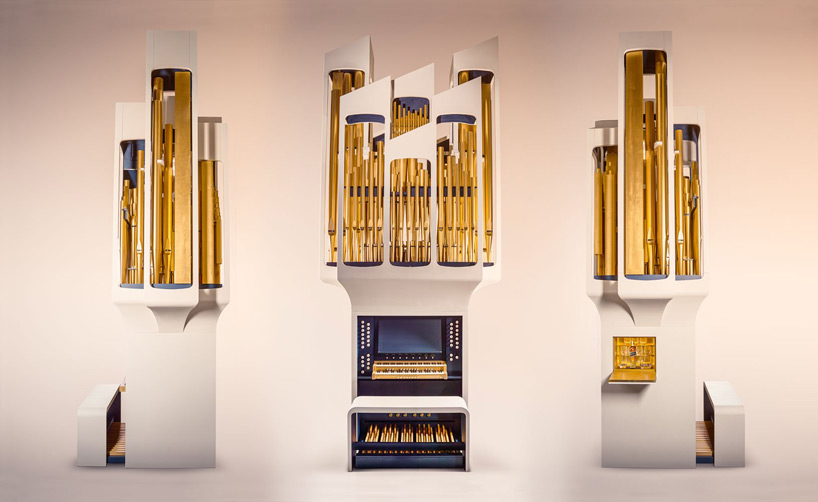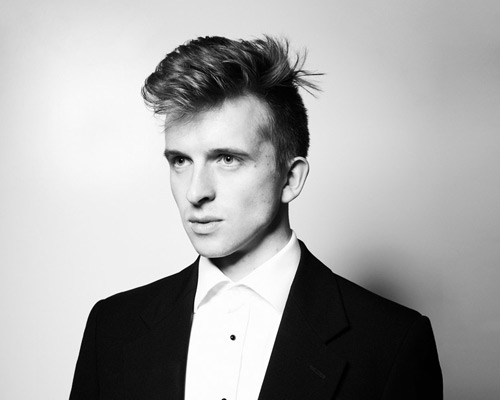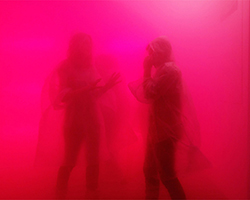designboom interview with sam bompas of bompas & parr
photo by ben ottewell
bompas & parr first came to prominence in 2007, through their experience in jelly making, but has since evolved and have become known for their tasting experiences; delivered through architectural installations, dinner parties or experimental laboratories. founded by sam bompas and harry parr, the london-based studio is comprised of a diverse team of individuals — from cooks and specialized technicians, to architects and designers — that brings forth all immersive productions that engage the senses, particularly through the way in which we consume food and drink. designboom speaks with sam bompas about the types of projects the studio enjoys working on most, if he has any superstitious beliefs he lives by, and what his definition of a successful ‘flavour-based’ experience is.

‘london eye chart’ – an illuminating pie chart reflecting the general election conversation on facebook
image courtesy of bompas & parr
designboom: what made you want to become designers, and how did you come to start collaborating together?
sam bompas: harry and I are old friends and have now known each other for most of our lives. it means that by now some of our staff think we are psychic – we’ve been talking about our approach to design, food, architecture and the cosmos few words need to be said to convey huge amounts of meaning. as harry’s not super talkative sometimes I have to translate his mysterious looks and laser eyes to the rest of the team!
we started bompas & parr nearly eight years ago as something fun to do on the weekend. it’s still fun to do but now has expanded to dominate all waking hours.
originally our focus was on jelly. as we couldn’t afford the antique copper moulds we wanted to use harry started using the skills, techniques and technologies he’d learned while training to be an architect to design jellies.
this approach of propagating techniques appropriated from different disciplines now is a key approach. we love the creative rush that comes with sitting down with an ethnobotanist, micro-biologist, experimental psychologist, mycologist or magician!
DB: how would you describe your approach to design?
SB: we design for maximal intensity of experience. everything is thought about from the perspective of the guest and we strive to add another element that is one step beyond the expected. we call this the ‘blow-jobs under the table approach’ the idea being to surprise and delight! 
‘the flavour conductor’ – the first working flavour organ realized in conjunction with johnnie walker
image courtesy of bompas & parr

alternative views of ‘the flavour conductor’
image courtesy of bompas & parr
DB: who or what has been the biggest single influence on your way of thinking and creating?
SB: when we started out we were focusing primarily on food. we had no formal culinary training and we’d worry when we read what folks were writing online ahead of attending one of our feasts or curated experiences. sentiments along the lines of ‘going to a b&p dinner tonight; going to be the best meal ever!’.
when you consider all the previous feasts that person would have consumed, ranging from michelin starred culinary odysseys, to sensual and luxurious tête-à-têtes via homely meals with cherished friends and family, the pressure was on. our lack of gastronomic schooling meant we would have to incorporate every trick we’d know to give people a memorable evening, by hook or by crook.
so as the evenings would unfold guests could expect table top fireworks, flying fondue that levitated above the table, live venomous snakes in the toilets and snail hunts across the table tops using custom made ‘atteletes’; effectively archaic meat jewellery that was once used to adorn pigs’ heads and roasts with truffles and blanched cockscombs.
we now apply the approach of total sensory assault on a much larger scale, be it creating breathable clouds of gin and tonic or cooking with 1.1 billion year old lava at 1350 degrees celsius.
it’s not all spectacle and showmanship (though our heroes are people like alexis soyer, P.T. barnum and edward bernays). a significant amount of historical, scientific and anthropological research underpins any given meal, project or installation. for the curious and intellectually hungry there is usually scads of essays and academic research that forms the basis of the project.
take for example ‘funland’: the pleasures and perils of the erotic fairground, our exhibition at the museum of sex in new york. the project is grounded in a wonderful essay by professor vanessa toulmin of the national fairground archive at the university of sheffield. the essay, entitled as graceful as they were disgraceful: eroticism and the fairground provides historic context and insight into carnivals and fairgrounds as spaces of transgression. if you read it at the museum you’ll probably get more out of the exhibition. that said, even without reading it, everyone still smiles when the jump onto the centre piece of the exhibition – jump for joy on a bouncy castle of breasts!

‘barajas jelly airport’ – served as a jelly version as a tribute to the architect richard rogers on his birthday
image courtesy of bompas & parr
DB: what would you say each of your strongest skills are, and how have you honed it over the years?
SB: we joke that I make the problems and then harry sorts them out. or to use a restaurant analogy, I do the front of house while harry is the powerhouse in the kitchen banging the food out.
harry’s now strangely good at unusual plumbing and takes great pride in his work. over the years we’ve had to engineer some strange feats of pipework such as a chocolate waterfall gushing at 12,000 litres an hour, and plumes of the cardinal flavours in guinness that visitors enjoyed with their nose at the guinness storehouse. regular plumbers had little experience with the hybridized technology to make this work so harry, a natural autodidact, mastered the requisite skills himself.
DB: what type of brief or project do you enjoy working on the most?
SB: ones with huge budgets that allow you to achieve feats that are otherwise impossible, or others that allow for great innovation and creativity.
the most rewarding projects to work on are invariably those that are the most challenging. though they are only really enjoyable in hindsight. when you are in the trenches they can seem terrifying, daunting and even life ruining. one of the key attributes of the world we have created is having an extremely short term memory in terms of remembering the struggles that are required for a successful project!

‘caketopia’ crazy golf with cake-themed obstacles
photo by beth evans

crazy cake golf’
photo by ann charlott ommedal
DB: what is the definition of a successful ‘flavour-based’ experience to you?
SB: one which puts a smile on people’s face and helps them to better articulate the often tricky experience of what is going on across their full taste apparatus! from their tongue, to nose, to digestive tract!
DB: what are your thoughts on specialisation vs generalisation?
SB: for us it’s important to have a studio loaded to the gunnels with generalists, who each have an address book of extreme specialists.

‘cooking with lava’ – grilling meat over 11500° C molten lava
image courtesy of bompas & parr
some hot cooking
image courtesy of bompas & parr
grilling meat over molten lava
video by robert wysocki
DB: do either of you have any superstitious beliefs or rules that you live by?
SB: magnificent question! we revel in superstition and the irrational and emotional power they have over people. one of my favourite projects was the sensed presence where we gave people a chance to experience a koren or ‘god’ helmet. the scientific community is divided as to whether the micro-electrical charges it uses to stimulate the brain’s temporal-parietal lobe induce a quasi-religious experience or it’s just people’s gullibility and bad scientific methodology that produces the results.
the interesting thing was that visitors certainly had profound experiences which they recorded after visiting the installation. though this could be because we’d taken their phone away from them for a full 15 minutes!
neither of us are remotely superstitious but also love how notions of the supernatural can help to further mystify and enchant the world. so we’ll frequently use tarot readers, rhapsodomancers, augers and tasseomancers at our installations.
tasseomancy is the art of fortune telling that interprets patterns of sediment, tea leaves or coffee grounds in the bottom off a glass.
as with all divinations and mystical practices anyone can have ‘the gift’. you just need to be bold (and possibly unscrupulous) enough to tell other people that you know what you are doing.
the subjects that most people spend their time thinking and worrying about are pretty much universal. so seers, mountebanks, mages and wise women, seeking to impress with fortune telling skills across the ages have always dwelt on health, sex, wealth, families, travel and relationships. focus your attention here and you are sure to succeed with swagger.
everyone has an important problem and some cherished hopes. just rootle around in those tea leaves until you tease them out. then luxuriate and elaborate around the themes.
the trick is to have some barnum statements (after the great showman and our hero P.T. barnum) ready to deploy. these are the assertions and suggestions used to powerful effect in horoscopes. though vague and general people think they apply specifically to them. here are some examples. think about how they apply to you and develop some that you could use on other people:
-you tend to be too self critical
-you get a little anxious in new social situations
-you have a strong need for approval and recognition.
-you’re an independent and creative thinker
-you do not accept what others tell you to believe
-you have sometimes told white lies to save another person’s feelings
barnum statements are of course total rubbish. they will, however, help give the querent faith in your skill and open then up. after that you can feed them any sort of mumbo jumbo about the future and it will feel credible.
the procedure
make a cup of tea using loose-leaf tea (not the leaves from cut-open tea-bags as are chopped too finely). ask your querent to drink off the tea then swirl the cup to distribute the leaves.
read from the present to the future, beginning at the rim near the handle and looking at the tea symbols in a downward spiral. at the bottom of the cup you find the future. try your hand at reading the positive images in the tea leaves and also the negative images created against the whiteness of the cup. leaves resembling a snake might mean enmity or falsehood while a mountain might be an obstacle or exciting journey. with a little practice you will be expert at tea-time entertainment and will learn the secrets and aspirations of all your guests.
the next step
once you have mastered tasseomancy move on to other food-based divination techniques like aleuromancy (flour), haruspicy (organs) or ovomancy (eggs!). assume the mantle of the complete food seer, don regalia, and help everyone you know glimpse their future and find enchantment in the dishes they eat each day.

‘glow-in-the-dark cornetto’ experience
see more about this project on designboom here

detail of the glowing frozen treat
DB: what are you currently fascinated by, and how is it feeding your work?
SB: meso-american egg healing, gene hacking, ultra-exotic fruits, stereoscopy and the creative possibilities that present themselves with when plants combine with computers.
oh, and mermen bartenders fixing drinks as they swim through the hot oceans!
all obsessions will eventually form the creative cornerstone of some sort of project or intervention.
DB: how do you try to keep your ideas fresh?
SB: reading books! everyone looks at the same stuff online so as a consequence comes up with work that all looks the same. we’ve now amassed an epic culinary collection. though it’s not the most comprehensive collection – mark hix has far more gustatory tomes – it’s incredibly eclectic and a sturdy basis for creative research. so books on the archaic toasting and funerary feasts sit with dieting with the duchess fergie’s figure secrets and slim while you sleep. with cookbooks written by barbara cartland, dali and coolio there’s normally somewhere to turn for inspiration. not all the books are outrageous or funny. there’s some serious works in there too – though they go unused.

‘funland’: pleasures and perils of the erotic fairground at the museum of sex in new york
see more about this project on designboom here

‘funland’ offers up a giant boob bouncy castle
DB: what is the best piece of advice you have ever received?
SB: following on from the last question! my grandfather said ‘never set up an account at alden and blackwell’ (a bookshop). it was ignored but to apocalyptic effect on the bank account.
DB: what is your motto?
SB: the studio’s motto is drawn from william blake ‘the road of excess leads to the palace of wisdom.’

sam bompass was a speaker at the 2015 WHAT DESIGN CAN DO! conference — an international platform about the power of design, promoting design as a catalyst of change and renewal and a way of addressing the societal questions of our time. formed in 2011 by a group of designers from various fields, it aims at showcasing best practices and visions, raising discussions and facilitating collaboration between disciplines, raising awareness among the public for the potential of creativity. at the same time, WHAT DESIGN CAN DO! calls on designers to take responsibility and consider how their work can impact the wider society.
happening now! in an exclusive interview with designbooom, CMP design studio reveals the backstory of woven chair griante — a collection that celebrates twenty years of Pedrali’s establishment of its wooden division.
















